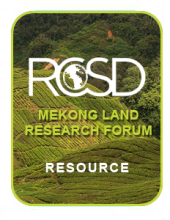Land Library
Welcome to the Land Portal Library. Explore our vast collection of open-access resources (over 74,000) including reports, journal articles, research papers, peer-reviewed publications, legal documents, videos and much more.
/ library resources
Showing items 1 through 9 of 22.Globally, the conservation and tourism sector is being enthusiastically promoted as one of the key mechanisms to catalyze rural local economic development.
The response of fragmented vegetation to human impact has been analysed in degraded and degrading areas in Tanzania (Lake Manyara).
The dramatic increase in migration and settlement in several areas where indigenous people live is leading to a multitude of problems for the original inhabitants.
ABSTRACTED FROM THE INTRODUCTION: My focus in this paper is on the kinds of development pursued by state agencies and large international aid organisations, and specifically, the displacement effects of what I am calling the new land tenure reform agenda.
Flow and concentrations of suspended sediment, nitrate-N, phosphate-P, atrazine, and metolachlor were monitored during the spring seasons of 1998 and 1999, primarily during storm events, at a tributary station (Big Ditch) and two main-stem stations (Fisher and Mahomet) of the Upper Sangamon River
The Natural Resources Conservation Service curve–number (CN) method commonly uses three discrete levels (1, 2, and 3) of antecedent moisture condition (AMC) to describe soil moisture at the time of a runoff event.
A framework is described that has been used to assess the effect of the European Commission's Agenda 2000 proposal on the Dumfries and Galloway region, Scotland. The model assesses the impact of agriculture on land-use patterns, the environment and socio-economics of the region.
We propose a simple mathematical framework to define consistently the environmental quality of a given landscape based on the relative abundances of the constituting land cover classes.
Using the UNFCCC as a basis, and the objectives of estimating soil organic carbon (SOC) changes during the period 1900–2100, a spatially explicit database of climate, land cover and soil texture was compiled for a 262,000 km2 region in semi-arid Sudan.



